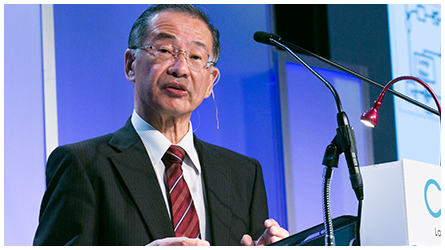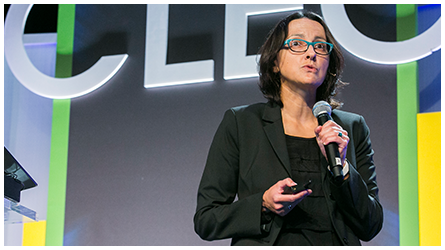By CLEO

Plenary II Recap: Masataka Nakazawa and Jelena Vuckovic
Mighty Advances in Quantum Nanophotonics
Today’s plenary session began with Masataka Nakazawa, of Tohoku University, presenting the latest developments in optical communication hardware in his talk, “’Multi’ is Everywhere.” Nakazawa highlighted three main categories of “multi” technologies advancing optical communications to the terabit and even petabit-per-second regime.
The first ‘multi’ Nakazawa discussed was that of multilevel coherent transmission. Using multiple modulation techniques, signal transmission is approaching fundamental bit error rate (BER) limits dictated by information theory. These techniques involve combinations of quadrature amplitude modulation, polarization multiplexing, and phase modulation for interweaving of multiple Nyquist pulses. Nakazawa reported single-channel rates approaching 4 Tbit/s for transmission over an impressive distance nearing 100km.
In the realm of structure, ‘multi’ applies to multi-core fibers, with up to 36 cores embedded in a fiber barely bigger than a hair width at 306 um. Though fabrication of these fibers still presents some challenge, especially at longer lengths, transmission rates for just 22 cores over a 31km fiber are a whopping 2.15 petabit/s.
The final multi of Nakazawa’s presentation applied to multimode control using multi-input multi-output (MIMO) methods. Multiplexed MIMO transmission over multicore fibers touted 115.2 Tbit/s over 125 km.
With multiple impressive transmission rates to reports, Nakazawa’s presentation certainly lived up to its claim that ‘multi’ is everywhere.
 Nanophotonic Devices Small Yet Mighty
Nanophotonic Devices Small Yet Mighty
For the second plenary session, Stanford’s Jelena Vuckovic highlighted progress in both fundamental and applied light-matter interactions in her presentation “Nanoscale and Quantum Photonics.”
When the two ingredients of light-matter interactions, as Vuckovic describes them, are coupled strongly enough we are able to investigate new hybridized states of light and matter. Quantum dots in optical cavity fields clearly demonstrate this coupling effect. Without such strong coupling, the resonances of a quantum dot and its a cavity field would cross each other.
The entangled state of the system appeared in Vuckovic’s experimental data as a clear anti-crossing of the resonances as a function of temperature. This was just one of this hybridized system’s energy eigenstates Vuckovic investigated. The story continued with various behaviors of the system, such as photon blockade and tunneling, stemming from the anharmonic spacing of the energy levels this hybridized system exhibits.
Extending this picture to arrays of quantum dots, cavity QED holds exciting future opportunities. Scaling up only slightly in size, Vuckovic also discussed her work developing linear 3D nanophotonic devices, such as wavelength and polarization splitters, that outperform their conventional counterparts by unique design methods. At a few microns in length, these odd looking structures are the result of linear parameterization of the design region, which connects the input and output channels, followed by boundary parameterization.
Not only can these broadband devices be closely packed, but exhibit robust performance over almost a 1000 K temperature range as well as 16 nm of fabrication imperfections. Vuckovic proved these nanophotonic devices, though small, are certainly mighty.
NOTES: If you did not have a chance to see the plenary presentation, or want to revisit it, the recorded presentation will be available on the CLEO website next week.
The plenary recap for David Reitze's presentation (Daily Wrap: Tuesday) was sourced from photonicsonline.com, written by Julia H. Majors
Posted: 8 June 2016 by
CLEO
| with 0 comments